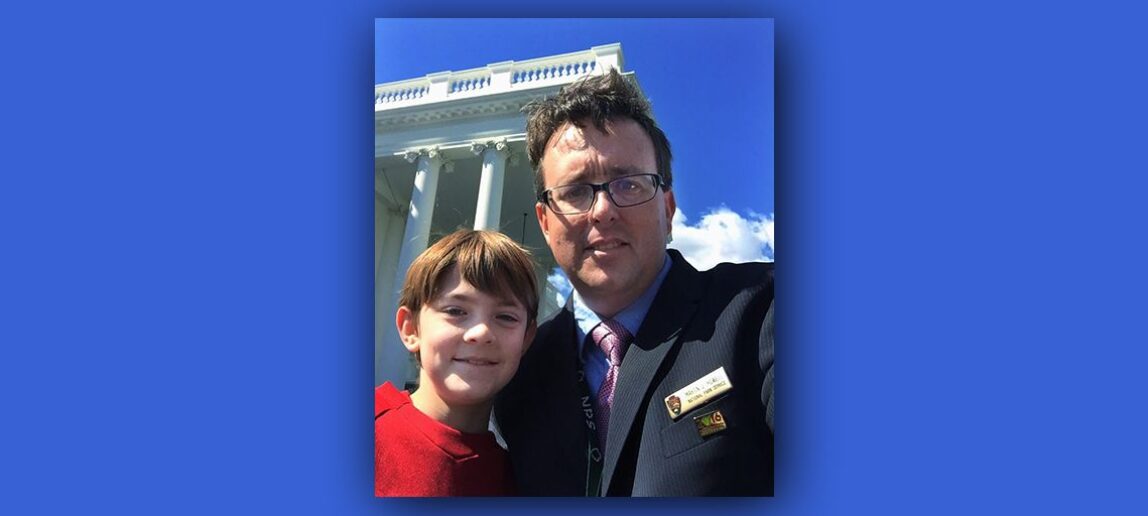Former design student helps preserve nation’s history
This holiday season, wreaths on display in each window of the White House will be hung with a custom-fabricated installation system, which prevents a significant amount of drilling into the historic building’s façade. The system was created by Martin Howell ’98, who was the senior architect at the White House and President’s Park from 2010-18.
During those years, Howell was the also the White House’s historic building’s preservation specialist. He planned, designed and provided project management for construction and rehabilitation projects at the historic building and its surrounding campus.
Howell, who now does similar work at more than 30 federal reserve banks as the manager of the reserve board’s planning section, reveals what it’s like to preserve “high profile” places like the White House and buildings in the federal reserve banking system.
Photo, courtesy Martin Howell, is of he and his son Adler in front of the White House.
Q: What is your role as the manager of the building planning section at the Federal Reserve Board?
A: I lead a small team of three highly skilled professionals — an architect, mechanical engineer, and electrical engineer — that supports the board in its oversight of reserve bank facilities across the country, including 12 head offices and 21 branch facilities.
At the macro level, we provide strategic planning, technical guidance, and financial assessment of facilities programs as well as oversight of reserve bank facility management programs. At a more micro level, we act as technical consultants to our banks and provide a thorough review of specific building construction projects during planning and design, and on through construction.
Q: What were your duties as the White House campus historic preservation specialist?
A: Many hundreds of people work at the White House campus every day. I often thought I was the only one that had any concern for the historic fabric of the White House.
I did my best to balance the historic properties of “America’s house” with the desire to host large events, maintain a secure environment, and accommodate the media and many other wants and needs of the various agencies working at the White House. Along the way I won a few battles and lost a few battles, but am content that I did my best to preserve this important building.
Q: Which of your White House projects are you particularly proud of?
A: I’d like to think I helped improve handicap accessibility at the White House during my time. The White House is one of the few buildings that is not required to meet the Americans with Disabilities Act.
I designed an accessible bathroom renovation for the China Room bathroom on the ground floor of the White House and an accessible ramp at the North Portico. The ramp was designed to have minimal visual impact to the north elevation. Perhaps best of all, it is completely reversible so that the ramp could be removed in the future and the north façade could easily be returned to its historic appearance.
Another favorite project is a system I designed to hang holiday wreaths at each window of the White House. This project was a high priority for first lady Melania Trump to add her own “signature” to White House holiday decorations. The solution is essentially an industrial-strength curtain rod and thin wires. These custom-fabricated, reusable rods allow the wreaths to be installed, and endure December wind and weather without making any holes in the historic stone or wood fabric of the façade.
Q: As the White House’s senior architect, you did eventually meet the president?
A: I worked regularly with staff from the Usher’s Office, Secret Service, the Executive Office of the President, as well as the fantastic staff of the National Park Service that helped to care for this iconic location. There were a few staff on the NPS grounds crew that had been around long enough to tell great stories about their interactions with Clinton, Bush (41), Reagan and even Carter.
My time as the White House’s senior architect with the National Park Service overlapped both the Obama and Trump administrations. Although I saw President Obama many times, I never met him in person. I did have the opportunity to meet President and Mrs. Trump a few times. But my favorite resident that I interacted with often was Bo, the Obamas’ Portuguese Water Dog!
Q: It would seem that any sort of White House construction, alteration, repair or rehabilitation project would involve the planning and OK of a number of entities — in other words, a lot of discussion, approvals, etc.?
A: That is indeed the case. There are many “fingers in the cookie jar” with any project on the White House campus. In addition, each of involved entity has different concerns and objectives. Balancing those concerns and objectives was a big part of my work there.
Q: In a “big picture” sense, what’s the importance of historic building preservation? What’s been rewarding about your career?
A: Historic buildings help tell the story of our past. In this digital age, where we can search for images in seconds, buildings of antiquity provide us with a physical presence to understand the physical size and spatial arrangements of a structure, as well as providing something tactile that we can see and feel.
They also provide a glimpse into the construction techniques and materials of an earlier time. Often, they are also samples of better and more enduring construction techniques than today’s methods.
Perhaps the most rewarding aspect of my career has been the variety of buildings I have been able to work on over the years. I am admittedly not a strong “design” architect, so historic buildings allow me to use my technical skills in architecture to maintain or restore structures from an earlier era.
And each project was different – a theater, a monument, a log cabin, a barn, etc. If I had to spend my days designing only banks or fast food restaurants or data centers, I would have certainly changed careers by now.
Q: Which professors at Texas A&M were particularly inspiring or important to your career?
A: David Woodcock, professor emeritus of architecture, has been, and continues to be, a great source of knowledge, inspiration, guidance (and friendship) that guides me daily in my professional career. His body of knowledge in the historic preservation field is second-to-none. (Woodcock is the founding director of what is today the college’s Center for Heritage Conservation.)
The late Dan MacGilvray, who was a member of the college’s architecture faculty, was also a great inspiration to me. Beyond general architecture knowledge, Dan taught myself and many others the importance of critical thinking that helps guide me in my daily work.
For more information, contact rnira@arch.tamu.edu or doswald@tamu.edu.


